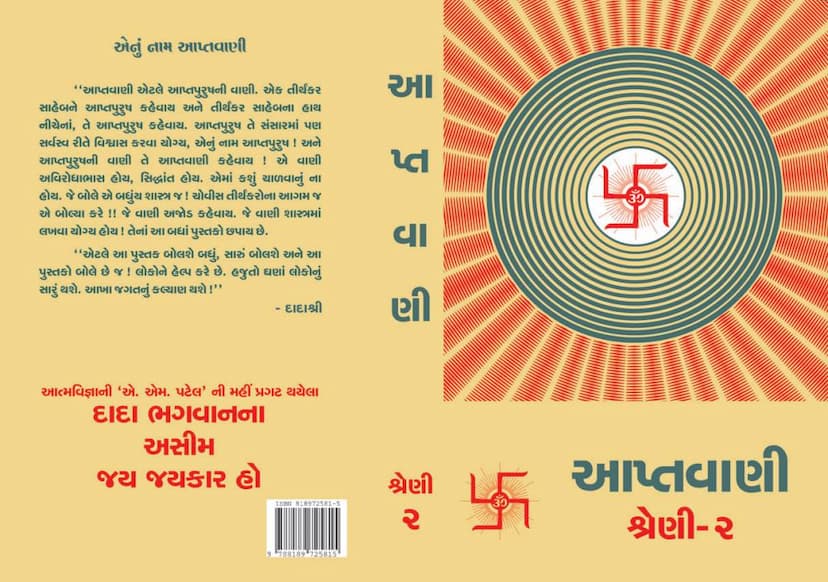Aptavani 02
Added to library: September 1, 2025

Summary
The text you provided is a Jain scripture titled "Aptavani 02," authored by Dada Bhagwan and published by Mahavideh Foundation. This comprehensive summary outlines the key themes and teachings presented in the book, based on the provided Gujarati text.
A Comprehensive Summary of "Aptavani 02" by Dada Bhagwan
"Aptavani 02" is a significant Jain text attributed to Dada Bhagwan, presented by the Mahavideh Foundation. The book is a compilation of Dada Bhagwan's spiritual discourse, aiming to guide readers towards self-realization and liberation.
Core Teachings and Concepts:
-
The Nature of "Aptavani": The book begins by defining "Aptavani" as the speech of an "Aptapurush" (a liberated soul or a person who has attained self-realization). Such speech is described as flawless, free from contradiction, and in accordance with established principles and scriptures. The words of an Aptapurush are considered inherently truthful and worthy of absolute trust.
-
Dada Bhagwan's Identity: The text clarifies the identity of Dada Bhagwan. It states that the physical body seen is not "Dada Bhagwan" but rather the awakened "Dada Bhagwan" residing within, who is the Lord of the fourteen realms. Dada Bhagwan himself states, "I am not God. The Dada Bhagwan manifested within is the Lord of the fourteen realms, and He is also within you, within everyone. He resides in you in an unmanifested form, and here He is fully manifested! I myself am not God. I also bow down to the Dada Bhagwan manifested within me." This highlights a profound distinction between the physical manifestation and the inner divine presence.
-
The Akram Path (The Non-Sequential Path): Dada Bhagwan's teachings are presented as an "Akram Marg," a direct path to self--realization. This is contrasted with the "Kramik Marg" (the sequential path), which involves gradual progress through stages. The Akram Marg is likened to a lift, offering a shortcut to self-discovery.
-
The Nature of the World and God: Dada Bhagwan challenges traditional notions of a creator God. He states, "The world is the puzzle itself. No father who created it has been born." The world operates through "scientific circumstantial evidences" and "causes and conditions" (nimitta). God, as a creator, is dismissed from this perspective, resolving the philosophical conflict regarding divine intervention. The world, in its entirety, is seen as a puzzle, the solution of which leads to self-realization.
-
The Science of Self (Atma-Vidya): The book delves into the science of the Self, explaining that the Soul (Atma) is pure, eternal, and unchanging. The complexities of the ego ("Aham"), mind, intellect, and consciousness are explained in relation to the Soul. The teachings emphasize understanding the Self as distinct from the body, mind, and worldly interactions.
-
Real vs. Relative Religion: A crucial distinction is made between "Relative Dharma" (samsaric interactions, mental, verbal, and physical conduct) and "Real Dharma" (Swadharma or Atmadharma). Relative religions (Jainism, Vaishnavism, Islam, Christianity) are seen as relative, whereas Real Dharma, or Atmadharma, resides solely within the heart of a Gnani Purush (a Self--realized being).
-
The Importance of a Gnani Purush: The text repeatedly emphasizes the indispensable role of a Gnani Purush in attaining Self--realization. It is through their grace and direct guidance that one can understand the Self and break free from the cycle of birth and death. Shrimad Rajchandra's quote is cited: "Seek nothing else. Just find one Satpurush (a truly wise person) and surrender all feelings at their feet. If you do not attain liberation then, take it from me."
-
Understanding Karmas: The book touches upon the nature of karmas and how they bind the soul. It explains that understanding one's true Self, the Soul, is the key to dissolving karmic bonds. The concept of "what is within the Self is not outside" and "what is outside is not within the Self" is central.
-
The Path to Moksha (Liberation): The ultimate goal is Moksha, which is described as freedom from all suffering and the attainment of pure bliss. This is achieved through Self--realization, understanding the true nature of the Soul, and living in accordance with the teachings of the Gnani Purush. The Akram Marg, as expounded by Dada Bhagwan, is presented as the most direct and effective way to achieve this.
-
The Nature of Suffering: Suffering is attributed to the identification with the ego and the worldly self, rather than the true Self (the Soul). The teachings aim to dismantle this false identification, leading to the cessation of suffering.
-
Principles of Right Living: While the ultimate aim is liberation, the text also offers practical guidance on navigating worldly life with equanimity and detachment. This includes the understanding of relationships, interactions, and the transient nature of worldly possessions and experiences.
Overall Message:
"Aptavani 02" is a profound spiritual guide that seeks to reveal the eternal truth of the Self, the Soul. Through Dada Bhagwan's direct teachings, it aims to dispel ignorance and lead seekers to the ultimate goal of liberation. The emphasis is on practical spiritual science, the understanding of the Self, and the guidance of a Gnani Purush, making the path to Moksha accessible and achievable, even amidst worldly life. The text encourages introspection, questioning, and the diligent application of the Gnani's teachings for spiritual progress.